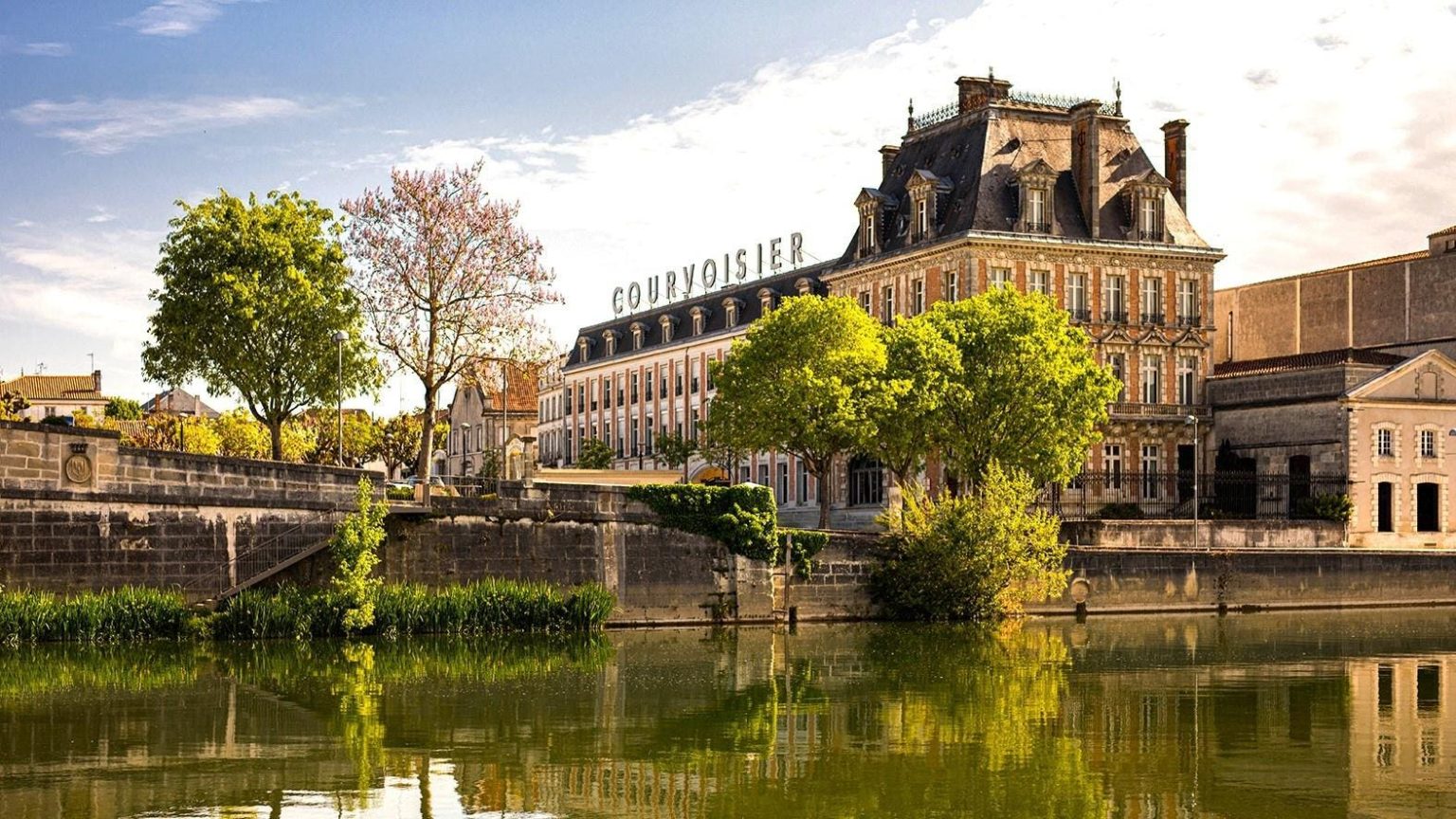The restoration of Maison Courvoisier on the banks of the Charente River in Jarnac in western France is complete. It is also well timed given that the house changed hands in May for a hefty $1.2 billion and will now be a focus for growth in the hands of new owner, Italy’s Campari Group, the owner of Aperol, Appleton Rum, and Wild Turkey.
Claimed to be the most awarded cognac house (based on the 20 top spirits competitions since 2019), Courvoisier, previously owned by Beam Suntory, is Campari’s biggest investment to date under highly acquisitive former CEO Bob Kunze-Concewitz who retired in April.
Before the purchase, Courvoisier had already started the multimillion dollar restoration of its grand maison in Jarnac, which also houses offices. The revamp, which was started in 2020 during the pandemic, took place in collaboration with Paris-based architecture and interior design agency Gilles & Boissier, led by husband and wife duo, Patrick Gilles and Dorothée Boissier and a team of local and international artists and artisans.
The agency is well-connected to the world of luxury having created interiors, from boats and restaurants to hotels and retail stores, for major global clients. They have included top-flight hotel groups like Mandarin Oriental, Four Seasons, Barrière Group, and currently Cheval Blanc.
The design group has also had a close association with billionaire Remo Ruffini, the man who revitalized winter jackets brand Moncler, turning it into a roaring success. Several of Moncler’s design-forward boutiques and his 180-foot superyacht, Atlante, were the work of Gilles & Boissier.
In Courvoisier’s own words the multi-year overhaul of the château is a “reawakening symbolising a determination to enhance cognac on the global stage.” The category certainly needs a new push having suffered big sales declines in recent years as recent numbers from rivals LVMH’s Hennessy and Rémy Cointreau attest.
Springboard to the future
Augustin Depardon, managing director of the House of Cognac and Champagne at Campari Group, said: “Maison Courvoisier is a piece of French history that was in need of revival after years of disuse. It has been an iconic part of the Cognac region’s fabric since 1828 and this restoration sets a stage for a beautiful future.” As one of the big four cognac producers the brand has the scale to make a difference in the global market.
The eye-catching five-story edifice, originally built in 1857, is inspired by the Pavillon de Flore at the Louvre Museum in Paris—a place dear to the house’s founder, Félix Courvoisier, who introduced the brand in 1828.
The transformation retains the characteristics of a lavish home infused by French heritage, regional terroir, and artistic culture. On the ground floor, the red cognac hues of the salon bar (pictured above) create a welcoming atmosphere to a modern space that narrates the story of the founder, curated by the house’s in-house historian, Isabelle Vignon.
She commented: “It has been an incredible journey to explore the brand’s history and honour it. Félix Courvoisier and his successors each left their mark on the maison (and) the restoration seeks to rejuvenate its soul with a contemporary touch.”
Adjacent to the salon bar is a tasting room adorned with an enormous piece of black-and-white art by Francois Houtin, paying tribute to the Charente landscape with details of vineyards and key landmarks. The dining room is a refined setting and the centrepiece of the château. Here guests can experience cognac pairing dinners at a palissandro marble table surrounded by carved wood-panel walls by Zoé Ouvrier.
Other art pieces from Anne-Charlotte Saliba, Lilian Daubisse, Carole Descordes, Molly Gambardella, and Veronique Van der Esch all express aspects of nature in ways that convey Courvoisier’s DNA from their individual viewpoints.
The soft power of hospitality
The restoration is one of Gilles & Boissier’s most significant long-term projects and in a statement it noted: “Exceptional levels of detail have been considered in every element of the design including a bench carved from a magnificent piece of wood from the cellar, testifying to Courvoisier’s deep attachment to its roots.”
Dorothée Boissier added that “the new look highlights the art of hospitality” and it does that brilliantly. Hospitality, or soft marketing, is one of the key roles of the château. The reopening is a new chapter and a select few trade partners, distributors, and media, for example, will be lucky enough to stay in the maison’s six bedrooms and experience the history of the place—from the gastronomy to the ancient cellars, and private tastings with Courvoisier’s master blender, Thibaut Hontanx.
There may be a potential window for cognac enthusiasts with deep pockets who want more than the typical public tours and tastings that are available. “Exclusive experiences to stay overnight will be arranged at restricted times,” the house said in a statement.
A decade ago, visitors who stayed at the château had a full brand immersion. Tanguy Bougeard, brand experience and heritage manager at Courvoisier told me: “This created an emotional connection. So it was important that the renovation was ambitious and took us back to our roots. It had to be warm, welcoming, and easy going so people really feel at home.”
The hosting element is clearly important to Courvoisier and it has also been forward planning in this area. “While progressing the project, we did everything in a way so that it could be opened up to private customers, but there are no plans for that as yet,” said Bougeard. With just six bedrooms, exclusivity and the chance to have tastings led by Hontanx will likely be lapped up by international cognac connoisseurs should a hotel option ever be available.
Innovation game
With the maison now looking resplendent, much now also rests on the shoulders of Hontanx. As Courvoisier’s master blender, he has the task of creating new lines in a difficult sales environment, particularly the US where more than half of Courvoisier’s revenue comes from.
He said: “We are fortunate to possess a legacy built on some of the rarest and most exceptional cognacs maturing in our cellars. The recent restoration perfectly complements the distinctive character of these blends.”
The house has an enviable inventory of maturing eaux-de-vie, with a book value of about $365 million consisting of balanced age profiles to support future brand expansion. The cellars and their contents highlight Courvoisier’s elevated brand position in the market and Hontanx plans to leverage that for product development, always sticking to the house’s signature floral style “cognac in blossom.”
He said: “The renovation is very important because receiving people, for example customer and wine growers, helps inspire innovation. As a master blender, I always have trials going on with barrels in the cellar just waiting to find the right market. We definitely have new products coming.” In the UK, for example, Rouge Luxe recently launched with Tesco, the country’s biggest supermarket chain. It is only available in the British market.
Special editions for luxury retailers like Harrods also continue to be a focus while restaurants and hotels, through for example food pairing, allow Courvoisier to widen its consumer reach.
Travel retail holds promise
Possibly where Courvoisier can lead the cognac category out of its current predicament is with its top end, exclusive products like L’Essence de Courvoisier, in travel retail stores.
Marco Cavagnera, managing director of global travel retail at Campari Group, commented: “The Courvoisier deal is a meaningful step change that enhances our offering and appeal within the brown spirits segment in travel retail and we are optimistic about the future of cognac in this channel.
“Travel retail is the ideal channel to develop the Courvoisier brand and introduce travelers to the broader Campari Group brown spirits and prestige rare portfolios. The strong experiential and storytelling aspects of travel retail make the channel a perfect platform to spread our new vision for Courvoisier.”
For Campari Group, Courvoisier represents a one-time opportunity to enter the top league of super-premium cognac. If it plays its cards right, the category will become the fourth major pillar of the group, joining aperitifs, bourbon, and tequila. Moreover, thanks to Courvoisier’s scale in the US, Campari will be able to significantly step up its presence there while also taking a bigger share in travel retail in Asia.
The restoration of Maison Courvoisier is therefore just the start of a far bigger strategic push for the brand as Campari homes in on what it calls the cognac house’s “great latent equity and highly acclaimed expressions.”
Read the full article here





